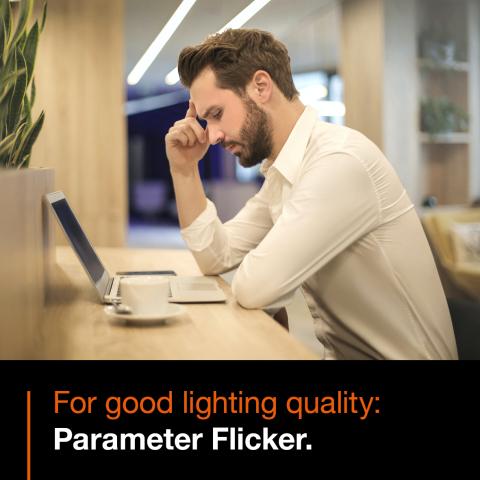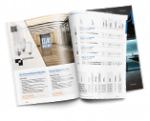An important parameter for good lighting quality.
We present: Flicker.

For many lighting experts, the most important parameters for the quality of good lighting are undoubtedly high illuminance, very good colour rendering, low glare or optimal uniformity. But another important parameter is becoming increasingly important: Flicker. Flicker is the effect of "flickering" and has a strong influence on lighting quality.
Basically, all electronic light sources can be described with a flicker factor, even if the flickering is not noticeable with every light source. And to ensure that light sources do not flicker too much, there are limit values in the EU directive (Single Lighting Regulation) from 01.09.2021 that must not be exceeded.
Flicker can be divided into two types:
- the frequency at which the individual pulses are perceived by the eye as single ones. As a rule, this occurs at a frequency of up to 60-80 Hz. This includes light sources that are operated directly on mains voltage or with conventional ballasts, i.e. at 50 Hz.
- the frequency at which the eye no longer perceives individual impulses as single impulses, but as a continuous stimulus. This usually occurs from a frequency of approx. 60-80 Hz. This includes light sources that are operated with electronic ballasts (EBs). ECGs for fluorescent lamps, for example, operate at >35,000 Hz.
The range between 60-80 Hz is also called flicker fusion frequency, because above this frequency people no longer consciously perceive flicker. Above a frequency of around 200 Hz - 400 Hz, the periodic light fluctuations no longer affect the human organism.
However, the perception of flicker does not only depend on the frequency. Every person notices flicker differently, and every light source converts flicker differently.
With incandescent lamps, for example, flicker has never bothered us much because the filament was too sluggish to convert the change in current into flickering. With fluorescent lamps, on the other hand, things look quite different: The gas filling reacts quickly to changes in current and converts them into often visible flickering. The fluorescent layer on the inside of the glass bulb and an appropriate electronic ballast can counteract this, so that the flickering is no longer perceived as annoying.
LED light sources react even faster than fluorescent lamps to changes in current. The flickering is correspondingly fast. How intensively the light flickers, however, depends on a number of factors, such as the LED driver used, the design of the luminaire and the light emission and dimming behaviour.
This is what many people are not aware of: flicker can not only be annoying but also dangerous for people. And not only consciously perceptible flicker, but also non-perceptible flicker. It affects our productivity and mood on the one hand, and our physical and emotional well-being on the other. Typical effects can include headaches, migraines and impaired vision and reading ability. In severe cases, it can even lead to sensitive people getting epileptic seizures.
And it is not only immediate physical danger that needs to be considered; the indirect danger from stroboscopic effects is also considerable. The stroboscopic effect occurs more frequently in the low-frequency range and is caused by a regularly changing entry of light into our eyes. This changes our perception to the effect that, depending on the frequency, movements become significantly slower or no longer discernible at all. Such stroboscopic effects can occur up to the range of around 2,500 Hz. In many areas, this can even be life-threatening if, for example, moving parts or tools on a machine look as if they are standing still. Safe and proper lighting, especially at workplaces, is therefore extremely important.
IEEE 1789 is a standard of the Institute of Electrical and Electronics Engineers that is recommended for planning and implementing lighting projects with regard to the issue of flicker.

